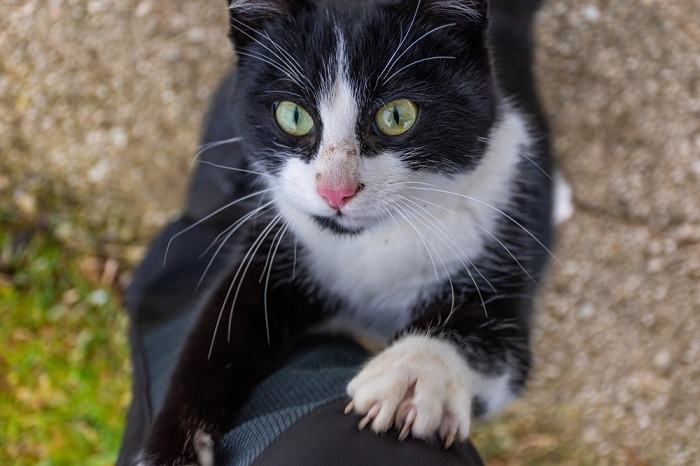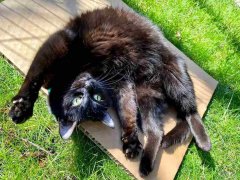
You might have noticed that your cat often looks like they stare at something for a while without blinking, or that your cat’s eyes are always open.
Key Takeaways
Cats blink using their third eyelid, or nictitating membrane.
A slow blink is your cat's way of telling you that they trust you and feel relaxed in your presence.
If you notice your cat blinking or squinting a lot, they might have something wrong with their eyes.
All cat owners are familiar with that long stare into the distance as if they’ve seen a ghost, and it often leaves us wondering just how long can cats go without blinking. Or do they even blink at all? Cats do blink, but not in the same way that we do, and in fact, cats can keep their eyes open almost all the time.
Do Cats Blink?
Cats’ eyes are very different than humans’ eyes. A cat’s eyes have different photoreceptor cells, so they see color differently than we do and they have a wider field of vision. Cats close their upper and lower eyelids to blink just like humans, but they don’t completely close.
It can sometimes look like your cat is squinting rather than blinking. Some cat owners worry that their cat isn’t blinking, but there’s no need to worry, they just do things a little differently.
Just like us, cats have tear ducts that produce tears to keep the eyes moist and clear of dust and debris. But instead of closing their eyes to blink, cats use something called the nictitating membrane, commonly known as the third eyelid. This special gland is involved in tear production. It is normally pink and can be seen in the inside corner of your cat’s eyes.
Usually, you can’t really see the third eyelid unless there is a problem with it, or if your cat is lying in a particular position. The third eyelid clears the eye of dust and debris by quickly moving across the eye, so they don’t lose their vision for any more than a split second.
Cats are predators, so in the wild, they wouldn’t be able to take their eyes off their prey for long, and their vision was essential for survival. So cats have evolved to be able to keep their eyes open almost all the time except when they are sleeping.
When humans blink, we do so to spread tears across the surface of our eyes to keep them moist and clean. But in cats, their tears evaporate off the eyes, so they get the benefit of blinking without having to fully close them. Cats also use their eyelids for protection, such as when they are walking through long grass or when they are hunting, to protect their eyes from damage.
The Menace Response

The menace response is reflexive blink that occurs when something comes close to the eye.
So we know that cats blink a little differently to us and that they don’t do it very often. So what does it mean when we do see them blinking? The menace response is the eye’s response to there being something very close to it. It’s a natural blink reflex where the eye closes to protect itself as an object moves toward it.
You might notice your cat blinks if you roll a ball toward them, or even when you move your hand toward them for a stroke. This isn’t a cause for concern, it’s a totally normal reflex and it actually just means that your cat is able to see.
Sometimes, vets use the menace response to check whether your cat has problems with their vision, and it can be helpful in diagnosing loss of eyesight, neurological conditions, and other diseases that affect your cat’s ability to see.
What Does It Mean if Cats Blink Slowly?
Humans blink around 15 to 20 times per minute on average, but cats don’t blink this often as they need to be able to be alert for signs of predators. The cat slow blink is different—aptly named, it takes around 5 seconds, and is your cat’s way of communicating with you.
It’s seen as the ultimate sign of trust and even a way of saying “I love you,” so be honored if your cat slow blinks at you. Closing the eyes in the presence of another human or animal means that a cat is happy and relaxed in their presence and sees no threat or danger. It’s often coupled with other submissive behaviors such as purring and rolling over.
Scientific reports by the University of Sussex and Portsmouth have found that cats are more likely to slow blink at their owners if their owners slow blink at them first. Cats are also more likely to approach someone, even strangers, who blink at them slowly and have a relaxed smile than someone displaying a neutral facial expression.
In contrast, when a dominant cat wants to assert their dominance or if a cat feels threatened, they will hold a long stare with no blinking at all.
What Does It Mean if a Cat Is Squinting?

If your cat is squinting a lot, or if you can easily see their third eyelid, they might have a problem with their eye.
Squinting can be very normal, as cats don’t close their eyes fully to blink using their eyelids. However, squinting can also be a cause for concern. Cats usually blink or clear their eyes using their third eyelid, and only occasionally use their eyelids, they usually use their eyelids to give you a trusting slow blink.
If your cat is squinting all the time, or if you can easily see your cat’s third eyelid, it could mean that there is a problem with your cat’s eyes that should be checked out by a veterinarian.
Squinting might be a symptom of pain or discomfort in the eye associated with inflammation, and sometimes the third eyelid can come across the eye when there is a problem. Disorders that can cause this are:
- Corneal ulceration
- Trauma to the eye
- Conjunctivitis
- Foreign objects in the eye
- Uveitis
- Glaucoma
- Hypertension (high blood pressure)
- Abnormal eyelash growth
- Facial nerve paralysis
- Toxicity
Other symptoms of an eye problem to look out for include:
- Holding the eye closed
- Discharge in the corner of the eye that is green or yellow
- Excessive tear production
- Pawing at the eye or rubbing it on the floor
- Redness or cloudiness in the eye
- Unable to blink or close the eye
If your cat is experiencing any problems with their eyes, get them checked over by a vet as soon as possible. Eyes are very sensitive and delicate, so it’s important that any problems are treated promptly. The vet might need to use some dye or local anesthetic, and some different colored lights to get a close look at all the areas of your cat’s eye.
Final Thoughts

When we talk about cats blinking, we really are referring to a number of different ways their eyes keep themselves clean and protected. Our feline family members have a different eye anatomy to us, so rather than regularly blinking to spread tears and clear dust and debris, cats use their nictitating membrane (third eyelid) to do this super fast without us even noticing.
This means cats don’t have to close their eyes to blink. A slow blink is a signal known to be a cat’s way of communicating their trust and love for you. But blinking or squinting can also be a sign that your cat has a problem with their eye that needs treatment from the vet. The next time you notice your cat staring into space or fixated on their prey, you can relax knowing that their eyes are taking care of themselves!
Also Read: The 7 Best Cat Wipes For Dander And Dirt
Frequently Asked Questions
Is it normal for cats not to blink?
Cats don’t blink like humans do, they use their third eyelid to quickly remove dirt and debris from the surface of the eye. They do it very quickly, so we rarely see it.
What happens if a cat doesn't blink?
If a cat doesn’t blink for a while, there’s nothing to be concerned about. Cats’ eyes work differently from ours. Tears evaporate from the surface of the eye, and they use their third eyelid to clear dust and debris.
How do cats stare for so long without blinking?
Cats are able to clear and lubricate their eyes in a split second using their third eyelid, so they don’t need to close their eyes to blink. In the wild, this means they don’t have to take their eyes off their prey.
How often do cats have to blink?
Cats don’t need to blink very often; they use their third eyelid to keep the eye lubricated and clear of dust and debris instead.







